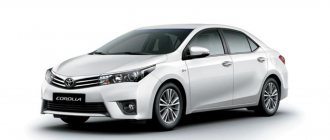Exterior of Toyota Prius ZVW30, third generation
The updated third-generation Toyota Prius has received a sportier look. The front part has complexly shaped headlights with LED lights that extend onto the hood line and a small radiator grille. The bumper turned out to be large, with recesses on the sides. They hide the fog lights. There is a wide air intake at the bottom.
TOYOTA PRIUS ZVW30
The profile of the car is distinguished by a sloping windshield and a neat sloping roof. Its line moved a little back and lengthened due to the installed spoiler. The rear optics are large with a rectangular shape and are also equipped with LEDs. Aerodynamics have become much better. The aerodynamic drag coefficient is 0.25.
The body dimensions are as follows: length – 4.48 m, width – 1.745 m, height – 1.505 m.
Toyota prius description
The Toyota Prius Hybrid consumes a minimal amount of fuel while driving. This result is made possible thanks to the internal structure of the machine, equipped with:
- hybrid power plant;
- planetary gearbox;
- generator;
- inverter;
- battery.
The internal combustion engine and the electric motor can operate simultaneously or alternately. This issue is resolved by the driver independently.
In a Toyota hybrid, the entire driving process is carried out as follows:
- The planetary gearbox divides the power and drives the gears.
- The gears are connected to an electric motor and a gasoline engine.
- The generator set provides energy to the electric motor.
- The generator charges the battery.
The last factor distinguishes this model from other similar ones that require a mandatory connection to the electrical network. If such a need arises, the Toyota Prius battery is charged directly from the internal combustion engine.
Exterior of Toyota Prius Hybrid
The Prius is a car characterized by impeccable exterior lines. Its body is streamlined, which optimizes the amount of fuel consumed and increases dynamic performance. The car of this brand belongs to the D class, in which it has the highest aerodynamic performance in comparison with other models. This figure is equal to 0.25 сх.
The appearance of the Prius has a number of features:
- sharp, sporty front end;
- complex shape of LED headlights;
- small radiator grille;
- carbon bumper overhangs;
- streamlined profile;
- sloping windshield;
- smoothly sloping roof;
- large trunk, slightly raised;
- the rear optics have an elongated shape, framed by an LED strip.
Dimensions of Toyota Prius:
- length 4.540 m;
- width 1,760 m;
- height 1,470 m.
Interior of Toyota Prius ZVW30, third generation
Inside, the first thing that catches your eye is the dashboard. It is placed under the windshield. This solution allows you not to be distracted from the road, and the steering wheel does not block it. Below is a 6-inch full-color touch display. The multimedia system is controlled using buttons on the steering wheel. The panel on which the automatic transmission lever is mounted has been raised a little higher, thereby facilitating access to the transmission controls.
Interior of Toyota Prius ZVW30, third generation
The side mirrors have a built-in electric drive, a turn signal and heating. The cabin has a 6-speaker audio system.
The cabin has two rows of seats for 5 people. It has the following overall dimensions: length – 1.905 m, width – 1.470 m, height – 1.225 m.
The front row is represented by comfortable seats with lateral support, adjustment zones and heating. The rear ones are a sofa for 3 people with enough space.
Trunk
The trunk volume is 445 liters, and with the rear row folded - 1120 liters.
Exterior and interior
Toyota Prius in the 30th body has been produced since 2009. Compared with the previous version, the new version has significantly improved aerodynamic characteristics - the drag coefficient has reached 0.25. At the same time, the dimensions of the car remained almost the same. The car body is designed for long-term use, so it is largely made from high-quality steel, using special structures that increase the safety of the car.
The height of the third generation Toyota Prius has not changed, but the length has increased to 4.46 m, the width of the car is 1.74 m. The highest point of the car has been moved back, which has helped to increase the free space above the rear row of seats. The racks have moved forward a little. Thus, the angle of inclination of the front window has increased and the changes in general have significantly improved the view of the road for the driver's seat.
In 2011, the car's frame underwent changes and an updated model was released with a restyled bumper and LED lights. Due to the new shape (large air intakes and additional foglights), the exterior has acquired a more aggressive look.
Toyota Prius 3 2009-2016
- body type: hatchback;
- body dimensions: 4.46 x 1.74 x 1.49 m;
- weight: from 1300 to 1500 kg;
- ground clearance: 14 cm;
- wheel diameter: R15-R17.
One of the most significant changes in the interior layout is the front panel, which is divided into two parts. The control system is located lower than its predecessor, and a lever for changing the travel mode is installed above the panel. The height of the steering wheel has been reduced by 10 cm, which makes driving more comfortable.
The design of the seats has been changed. The front backrests have decreased in width and are now adjustable, which helps provide a more comfortable position for rear-row passengers. The battery received a smaller cooling system, and thanks to this, the luggage compartment increased by 30 liters.
Note: the total trunk volume is 445 liters, and with the rear row of seats folded down - over 1100 liters.
Type of hybrid installation
The Toyota Prius 30 is based on the front-wheel drive “New MC” platform. The front axle is equipped with independent MacPherson struts, and the rear axle is semi-independent, based on a torsion beam. The entire suspension is equipped with stabilizers.
Hybrid engine
The structure of the hybrid system corresponds to a series-parallel circuit. It includes an internal combustion engine, an electric motor, a VVB and a power flow divider. The torque from the hybrid engine is distributed using a divider. Excess energy is used to recharge the battery. The car starts on electric power. The regenerative braking function also helps replenish the charge.
The total power of the hybrid power plant is 136 hp.
You might be interested
You can find out more about all generations of Toyota Prius HERE.
Description of the operating modes of the hybrid power plant
Engineers have provided three driving modes for the Prius ZVW30:
1. ECO mode
A mode in which fuel costs are minimal. The car is very sluggish and goes into electric mode at low speeds.
2. EV mode
Movement on an electric motor, but at low speed and limited distance.
3. PWR mode
Both motors operate at maximum power. The car reacts very sharply to acceleration and braking. It is better to use on a flat track.
Technical characteristics of Toyota Prius ZVW30, third generation
The developers were going to make an economical city car. They did it. The main technical characteristics are given in the table:
| Engine capacity | 1797 cm3 |
| Wheelbase | 2700 mm |
| Clearance | 140 mm |
| Turning radius | 5.5 m |
| Front and rear track | 1525 mm and 1520 mm |
| Fuel tank | 45 l |
| Wheel size | 195/65 R15 |
| Brakes (front/rear) | Ventilated disc/disc |
| Discs | 15Х6J |
| Spare wheel | full size |
The note! The spare wheel is located in the luggage compartment, in a special niche.
Spare wheel
Transmission
There is no traditional gearbox in the car. A continuously variable CVT transmission is installed here. The planetary part connects all the gears, ensuring their fixation. Such a mechanism ensures a smooth change in stroke when increased torque is supplied. This transmission requires special care and constant oil changes.
Gas engine
The 3rd generation Toyota Prius hybrid is equipped with a 1.8-liter 2ZR-FXE four-cylinder engine. Power is 99 hp. at 5200 rpm. Torque reaches 142 Nm. The unit operates according to the Atkinson cycle. It allows you to minimize friction and increase the compression ratio of the engine.
In addition, the internal combustion engine is equipped with distributed fuel injection and a Dual VVT-i gas distribution system.
Electric motor
A pair of internal combustion engines is made up of a synchronous electric motor-generator. The electric motor is located at the front of the car. Power is 60 kW. Torque – 207 Nm.
The electric motor performs two functions - a traction motor and a generator that produces energy. Takes part in regenerative braking, charging the VVB.
Battery and mileage on one charge
The Toyota Prius ZVW30 model is equipped with a nickel-metal hydride battery pack located under the rear row. The voltage is 200 Volts. Power – 1.3 kW. Capacity – 6.5 Ah. VVB is capable of withstanding 2000 charge/discharge cycles.
On one charge, the car travels a maximum of 3 km under ideal conditions. Travel speed is limited to 60 km/h. Although, usually the internal combustion engine is connected already at 50 km/h. If the VVB fails, its replacement will cost 110,000 rubles.
Toyota Prius III XW30
A fashionable gadget, a toy for older children or a practical means of transportation. This car can be perceived in different ways, but the fact remains that the Prius is interesting to a very wide audience. However, for many, the new hatchback is prohibitively expensive. Believe me, the car of the previous, third generation is hardly worse
Let's face it, with the loudly declared fantastic efficiency of the Prius - according to the passport data, the third-generation model in the combined cycle consumes 3.9 l/100 km - the real fuel consumption is noticeably higher. We operated a Japanese hybrid for quite a long time in Moscow, where the car required from 5.5 to 6 liters of gasoline for the same “hundred” mileage. On the highway, where the gasoline engine not only plows alone almost all the time, but also carries a 45-kilogram high-voltage battery on its shoulders, the flow meter showed 7-7.5 l/100 km. Twenty years ago, these were practically unattainable figures for golf-class cars with naturally aspirated engines and automatic transmissions, but now, in the era of global downsizing of engines and the introduction of start-stop systems, cars with traditional power plants have learned to drive no less economically.
It’s not just that I mentioned the Prius’s twenty-year presence on the market. Over the past years, the technical concept of the machine has not changed at all. This is a body with a low aerodynamic drag coefficient and a power unit packed into it, consisting of a high-voltage battery, a gasoline engine, a starter-generator and an electric motor. The playing of this quartet is conducted by an inverter and a planetary gearbox, which allows the car to move forward or backward, as well as maintain engine speed in optimal modes.
At the same time, remaining faithful to the general idea, each new generation of Prius entered the market with something new. Perhaps the main technical difference between the third generation car (XW30) and its predecessor was the 2ZR-FXE gasoline engine. The tandem of this 1.8-liter (previously 1.5-liter) gasoline four with an electric motor develops 136 hp. Not enough, you say? This, by the way, is 14 “horses” more than the current fourth Prius. And it’s not, in fact, what’s great about them, but the impressive torque, which ensures brisk starts and lively dynamics in the city. However, for those looking for an aftermarket hybrid Toyota, its reliability is no less important than the speed it develops. This is not an idle question, especially since you can’t buy a five-year-old Prius from us for less than 650 thousand rubles. This is what they ask for for right-hand drive models; left-hand drive cars are on average 150 thousand rubles more expensive. As you can see, the amounts are decent.
On many forums you can find remarks that Priuses have a significantly longer service life than regular cars. Yes and no. You can’t argue with the fact that the parts of the hybrid brake system (pads and discs) are subject to minimal wear, since the starter-generator does a significant job of slowing down the car in recuperation mode. The gasoline engine also gets less, since its speed does not leave the optimal zone, and often movement occurs only due to electric traction. In general, with normal care, timely replacement of oil and filters, the internal combustion engine, and with a mileage of 300 thousand km, it is in perfect health. But whether this engine can last another hundred thousand without repair is a question.
But counting on the eternal life of shock absorbers, silent blocks, and suspension stabilizer struts is naive. These Prius parts are subjected to the same loads as those on a Corolla of similar size and weight. Consequently, their service life is approximately equal. Finally, about the most exciting thing - the traction battery. The thing is really tenacious (designed for the entire life of the car, that is, 300-350 thousand km), it is difficult to kill, but still possible. Therefore, do not skimp on a comprehensive check of the copy you like in an authorized or verified club service. Like all similar batteries, the Prius battery does not tolerate overheating, therefore you need to carefully monitor the condition of its cooling fan, and under no circumstances carry out welding work in the immediate vicinity - for example, during body repairs. Another piece of advice from experienced vehicle drivers is to not leave the car for a long time (two weeks or more) without moving. If the battery is empty, the car will not move, and the internal combustion engine will only start when moving. There is only one way out in this situation - a tow truck and a trip to the dealer.
Suspension
The chassis is quite simple: there are McPherson struts at the front and a torsion beam at the rear. There are no systemic problems with the chassis. Only planned replacements. Shock absorbers serve an average of 60-80 thousand km. (5000-6000 rubles per piece). At the same time, it is optimal to change the bushings (RUB 250-A00) and struts (RUB 1,700-2,300) of the front stabilizer
Transmission
Here again everything is very simple. The function of transmitting traction from a gasoline and electric motor to the wheels is assigned to a planetary gearbox, which also acts as a gearbox. It takes a lot of effort to kill him. However, service technicians recommend changing the oil in this unit every 60 thousand km. The issue price is 3000 rubles.
Engine
For better efficiency, the Prius is equipped with a gasoline engine operating on the Atkinson cycle. In such an engine, the compression stroke is shorter than the power stroke. But you don’t need to know this at all, because scheduled maintenance of this unit is no different from caring for an ordinary engine. That is, we change the oil and filters every ten thousand, in extreme cases - every 15 thousand.
Body
High-quality preparation and painting of the body protects it from corrosion for a long time. However, not a single used car is immune from chips, which, after contact with reagents, can turn into quite large ulcers. The plastic face is not in danger of such a misfortune, but we recommend that you inspect the windshield pillars and sills with passion.
Electrics
Avoiding overheating is the main condition for extending battery life. However, if it fails, it is not always necessary to purchase a new battery (65,000 rubles). More often you can get by by replacing several blocks that make up the battery. They are completely interchangeable and, depending on the region and the seller, cost about 2000-3000 rubles apiece.
Advantages and disadvantages
+ Real fuel economy in urban modes, positive image, spacious interior, roomy trunk, commendable reliability with proper care
– Long warm-up of the interior at low external temperatures; in order to avoid discharge of the traction battery, long periods of downtime without movement are unacceptable
Fuel consumption per 100 km and dynamics of Toyota Prius ZVW30, 3rd generation
The maximum speed of the hybrid is limited to 180 km/h. Acceleration time to “hundreds” is 10.3 seconds.
In the city, 3.9 liters of gasoline will be consumed. On the highway the figure is 3.7 liters of fuel. Fuel consumption in the combined cycle will also be 3.9 liters. In reality, the figures will be higher by a maximum of 2 liters per 100 km. Consumption is highly dependent on fan usage and cooling.
Important! On the Prius you can install special solar panels on the roof. The entire interior ventilation system will be powered from them. This method removes the dependence of gasoline consumption on ventilation.
To reduce fuel consumption, you can use the following effective methods:
- reduce the speed so that the electric motor starts working;
- do not brake or accelerate suddenly;
- slow down in advance when you detect an obstacle;
- monitor tire pressure;
- undergo maintenance in a timely manner.
Options and prices Toyota Prius ZVW30, third generation
For the Russian market, the 3rd generation hybrid Toyota Prius is available in three trim levels: Elegance (basic), Prestige and Luxe.
Toyota Prius ZVW30, third generation rear view
The initial configuration of Elegance will cost 1,777,000 rubles and is described above.
The Prestige package includes:
- electric luggage compartment;
- leather upholstery;
- audio system with 8 speakers;
- Cruise control.
The price will be 1,980,000 rubles.
The top-end Luxe package is additionally equipped with:
- navigation system;
- electric sunroof;
- audio system of 11 speakers;
- intelligent parking assistance system;
- front and rear parking sensors.
The cost will reach 2,130,000 rubles.
Reference. All prices are for new cars.
Specifications
On the Russian market, the car is sold in Elegance and Prestige trim levels. The latter includes several additional options (intelligent parking assistance system, projector display, on-board computer touch system on the steering wheel, navigation system with a hard drive in Russian, LED lighting elements, a system for facilitating access to the car and starting the engine).
Engine
The power unit of the Toyota Prius 3 includes a 1.8-liter engine and an electric motor. Energy for the electric engine is supplied from nickel-metal hybrid batteries with a capacity of 6.5 ampere-hours. Fuel consumption is 3.9 liters per hundred kilometers. The power reserve is 1,150 kilometers, the aerodynamic drag indicator is reduced to 0.25. Carbon dioxide emissions are 89 grams per kilometer.
As befits a hybrid engine, when idle, the gasoline engine is completely turned off, which makes it possible to reduce fuel costs. In general, a gasoline engine operates primarily in the mid-speed zone. The car is capable of driving on one electric motor, but only for short distances and at low speeds. At the same time, the electric motor of the machine is completely environmentally friendly and silent.
Detailed parameters of the internal combustion engine:
- maximum power – 99 horsepower at 5200 rpm;
- highest torque – 142 newtons per meter at 4000 rpm;
- configuration – in-line four-cylinder;
- number of valve elements – 16;
- cylinder radius – 40 millimeters;
- piston stroke - 88 millimeters;
- compression level – 13;
- power supply system – distributed injection;
- lubrication system - full flow under pressure;
- cooling system – liquid;
- number of cycles – 4.
Technical characteristics of the electric motor and batteries:
- type – synchronous-magnetic;
- power – 82 horsepower;
- torque - 207 newtons per meter.
Lubricant and filter elements must be replaced every ten thousand kilometers.
Transmission
The transmission unit of the Toyota Prius 3 is classified as an automatic type (planetary gearbox) and has one gear. The car is front-wheel drive. Experts advise replacing the oil fluid in a planetary gearbox every sixty thousand kilometers.
Electrics
The dashboard of the car is equipped with a seven-inch touchscreen multimedia system. Nearby is the climate control control unit and the joystick of the transmission unit. On top of the monitor there is another display showing the current parameters of the car (fuel volume, speed). There are electric windows.
Modifications
Toyota Prius, 3rd generation is sold in two trim levels, a description of the differences (including price) is shown in the table:
| Equipment | Elegance | Prestige |
| Price | RUB 1,149,000 | RUB 1,399,000 |
| Front lighting washers | No | Eat |
| Indicator light | No | Eat |
| Leather steering wheel cover | No | Eat |
| Fabric upholstery | Eat | No |
| Leather upholstery | No | Eat |
| Electrically heated front seats | No | Eat |
| Parking assistant | No | Eat |
| Cruise control | No | Eat |
| CD changer | No | Eat |
| Audio system options | Six speakers, AUX | Eight speakers, AUX |
| Navigation system | No | Eat |
| Full color LCD display | No | Eat |
| Rear view camera | No | Eat |
| Dimmable rearview mirror | No | Eat |
| Rain indicators | No | Eat |
Reviews of Toyota Prius ZVW30
Review from Roman
I drove a Prius for 3 years in the 2nd body. Now I bought a ZVW30. I'm happy with the car. It has already survived 2 harsh winters, nothing has failed yet. I only changed consumables. You feel confident on the road; the hybrid holds the road even at maximum speed. Aerodynamics are excellent.
Review from Sergey
I bought a car for my family. Immediately increased the ground clearance by 20 mm. With our roads, the factory one was not enough. I've been driving for 4 years now. I had to change several VVB modules. So far there have been no more problems. I'm happy with the car.










